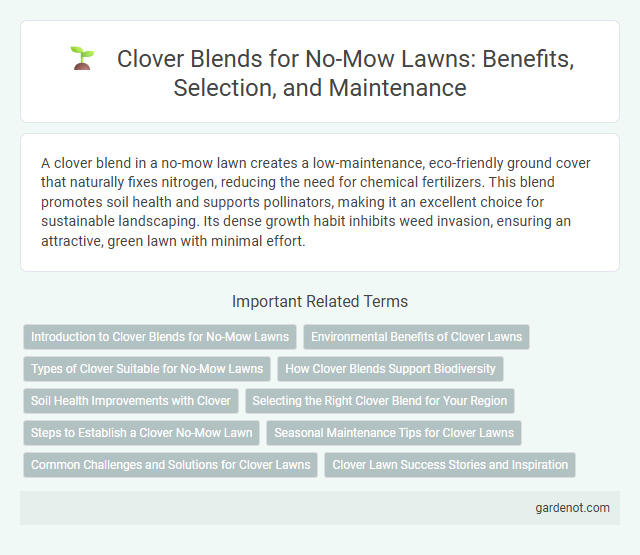A clover blend in a no-mow lawn creates a low-maintenance, eco-friendly ground cover that naturally fixes nitrogen, reducing the need for chemical fertilizers. This blend promotes soil health and supports pollinators, making it an excellent choice for sustainable landscaping. Its dense growth habit inhibits weed invasion, ensuring an attractive, green lawn with minimal effort.
Introduction to Clover Blends for No-Mow Lawns
Clover blends offer a resilient and eco-friendly alternative for no-mow lawns, promoting soil health and natural nitrogen fixation. These blends typically combine microclover with other low-growing species to create a lush, weed-resistant ground cover that requires minimal maintenance. Incorporating clover blends reduces water usage and supports pollinators, making them ideal for sustainable landscaping solutions.
Environmental Benefits of Clover Lawns
Clover lawns significantly reduce the need for synthetic fertilizers due to their nitrogen-fixing capabilities, enhancing soil fertility naturally. Their dense growth suppresses weeds and promotes biodiversity by providing habitat and food for pollinators like bees and butterflies. Clover's deep root system improves soil structure, increases water retention, and helps mitigate soil erosion, contributing to a healthier ecosystem.
Types of Clover Suitable for No-Mow Lawns
Trifolium repens, commonly known as white clover, is the most popular type for no-mow lawns due to its low growth habit and excellent nitrogen-fixing ability. Microclover, a smaller variant of white clover, blends seamlessly with grass, providing a dense, resilient, and low-maintenance ground cover. Crimson clover offers vibrant red flowers and can be used in no-mow lawns for seasonal color and soil enrichment, though it grows taller and may require occasional trimming.
How Clover Blends Support Biodiversity
Clover blends enhance biodiversity by attracting a diverse array of pollinators such as bees and butterflies, which play a crucial role in ecosystem health. These low-maintenance plants enrich soil nitrogen naturally, reducing the need for chemical fertilizers and supporting beneficial soil microorganisms. Their dense growth also provides habitat for various insects and small wildlife, fostering a balanced and sustainable lawn environment.
Soil Health Improvements with Clover
Clover blend seeds enhance soil health by fixing atmospheric nitrogen, reducing the need for synthetic fertilizers and improving nutrient availability for surrounding plants. Its deep root system promotes soil aeration and moisture retention, leading to increased microbial activity and overall soil fertility. Integrating clover into a no-mow lawn supports sustainable turf management by naturally enriching the soil and promoting robust grass growth.
Selecting the Right Clover Blend for Your Region
Selecting the right clover blend for your no-mow lawn depends on your regional climate, soil type, and rainfall patterns. Common choices include white clover for cooler, temperate zones and microclover varieties suited to warmer or drought-prone areas. Properly matched clover blends improve lawn resilience, reduce maintenance needs, and enhance nitrogen fixation for healthier, sustainable turf.
Steps to Establish a Clover No-Mow Lawn
Prepare the soil by removing weeds and loosening the topsoil to ensure optimal root growth for the clover blend. Sow high-quality clover seeds at a rate of 1 to 2 pounds per 1,000 square feet, then lightly rake the area and water thoroughly to promote germination. Maintain consistent moisture during the first three weeks and avoid mowing until the clover reaches at least three inches in height to establish a healthy no-mow lawn.
Seasonal Maintenance Tips for Clover Lawns
Clover blend lawns require minimal mowing, thriving with seasonal care that includes early spring overseeding to maintain density and late summer irrigation to support deep root growth. Applying a balanced, low-nitrogen fertilizer enhances clover health without promoting excessive grass growth. Regularly monitoring for pests such as white clover weevils and managing weeds with selective herbicides ensures a vibrant, low-maintenance lawn year-round.
Common Challenges and Solutions for Clover Lawns
Clover lawns often face challenges such as patchy growth, susceptibility to pests like aphids, and difficulty competing with aggressive weeds. Regular mowing at higher settings, combined with proper fertilization using phosphorus-rich compost, promotes dense clover growth that crowds out weeds. Introducing beneficial insects and applying organic pest control methods effectively manage aphid populations without harming the lawn's ecosystem.
Clover Lawn Success Stories and Inspiration
Clover blend lawns have demonstrated remarkable resilience and low maintenance in various success stories, showcasing vibrant green coverage even in drought-prone regions. Homeowners report significantly reduced mowing time and decreased need for synthetic fertilizers, thanks to clover's natural nitrogen-fixing properties. These inspiring examples highlight clover lawns as an eco-friendly, sustainable alternative to traditional grass, promoting biodiversity and soil health.
Clover blend Infographic

 gardenot.com
gardenot.com